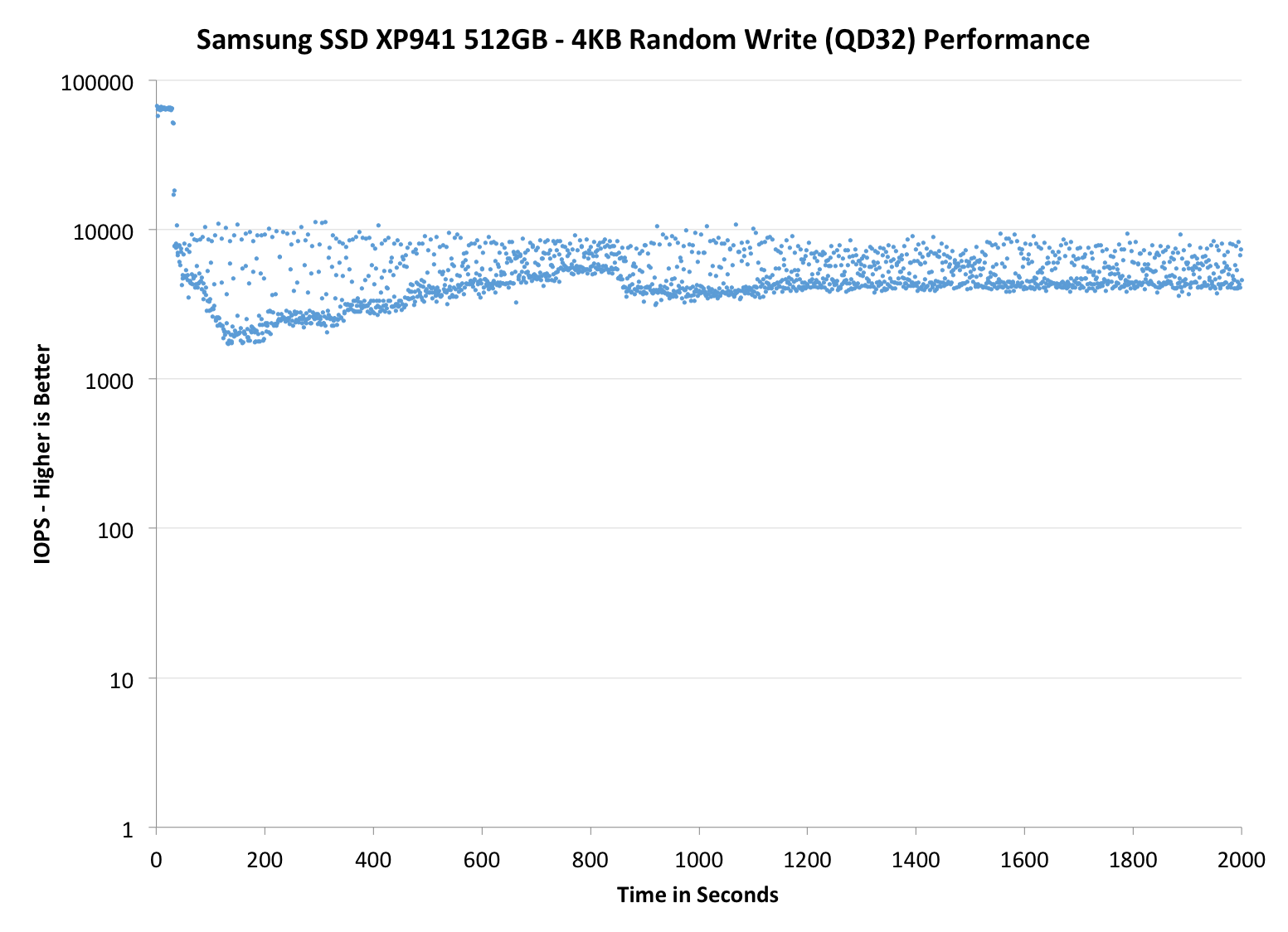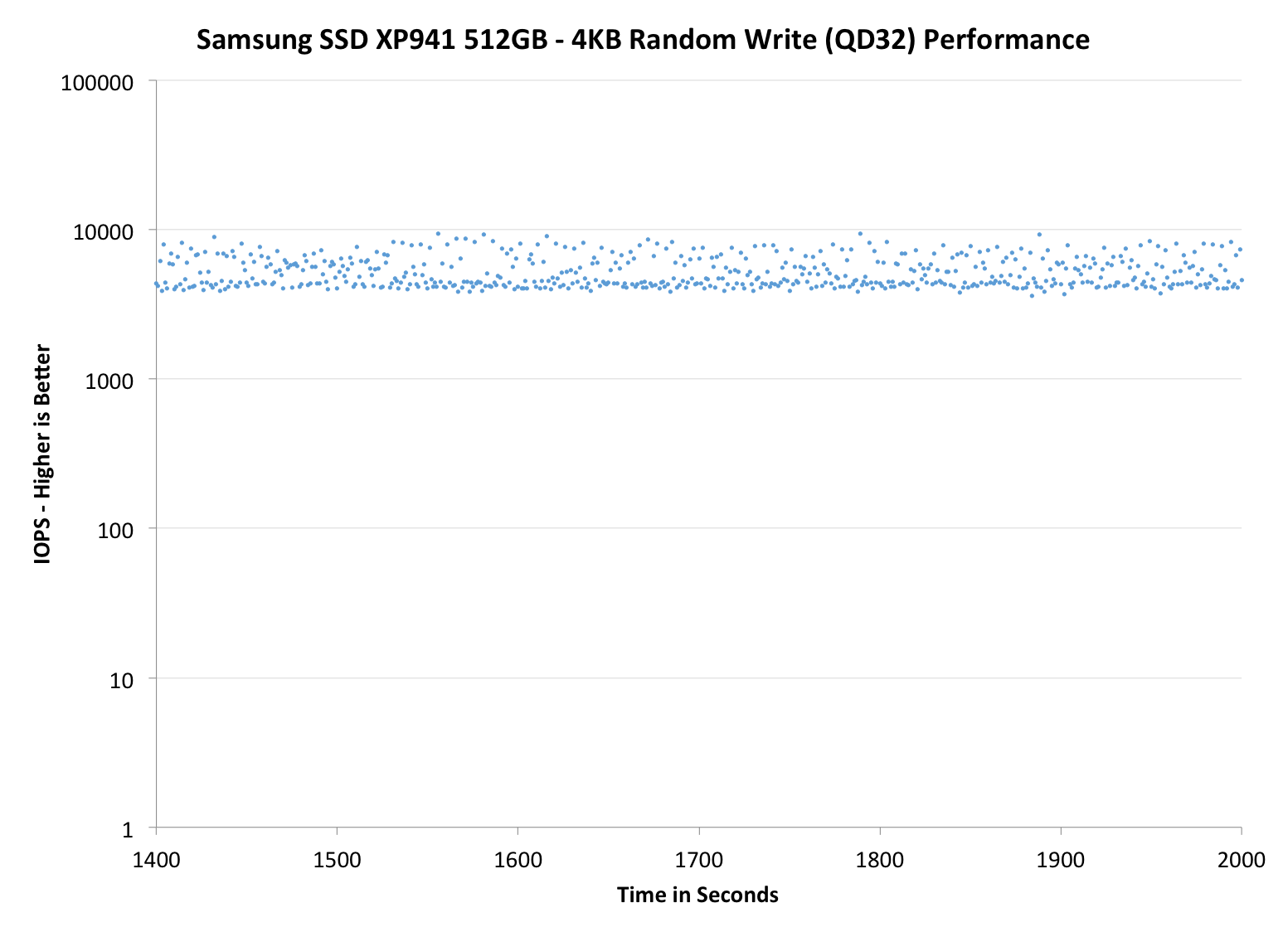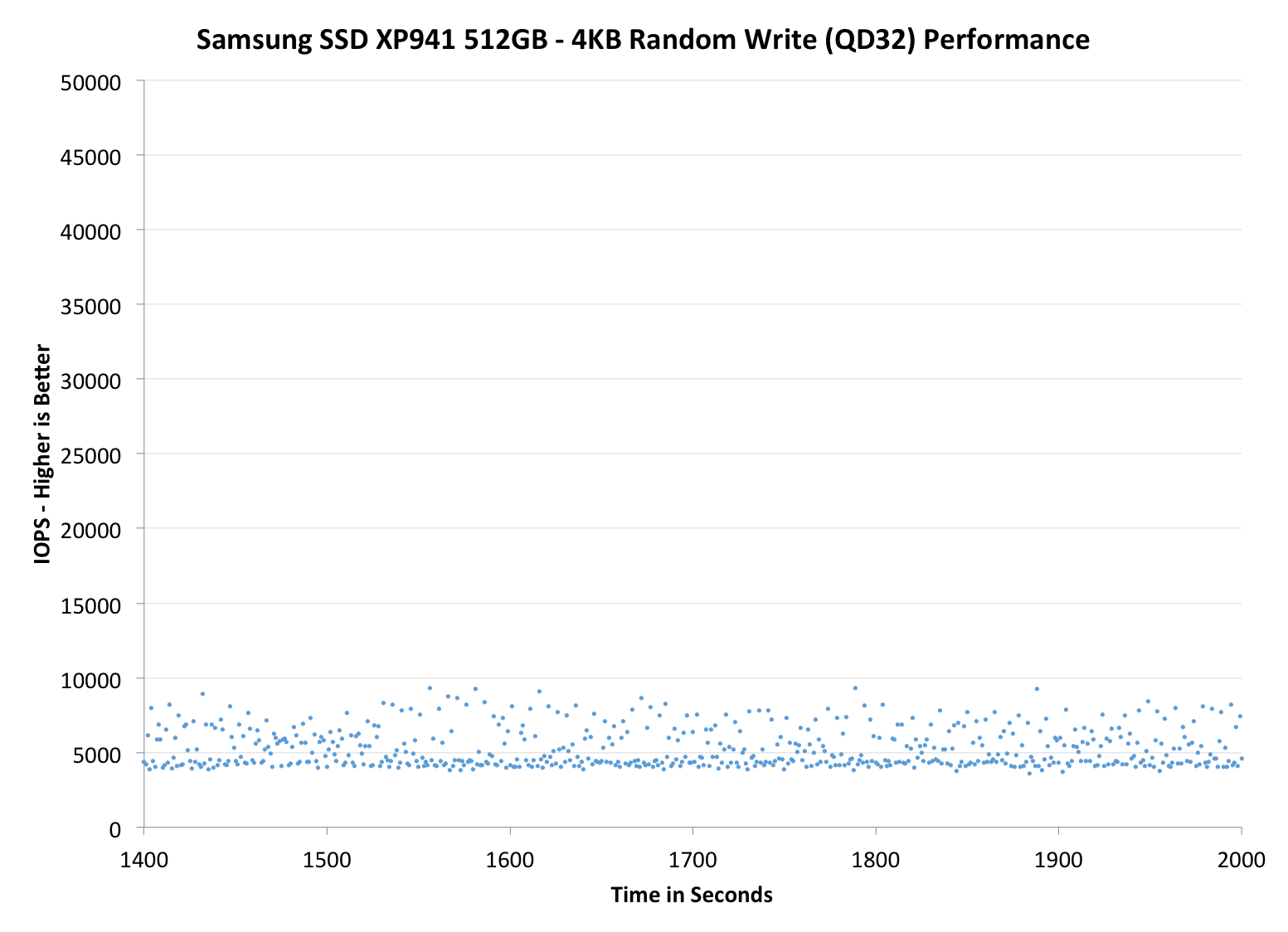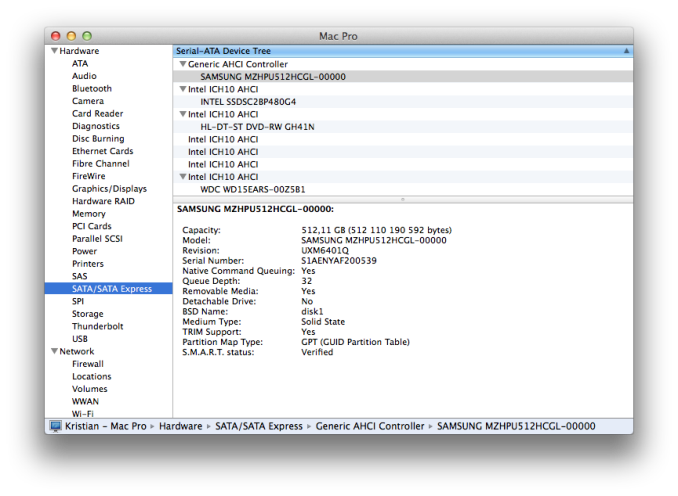Samsung SSD XP941 Review: The PCIe Era Is Here
by Kristian Vättö on May 15, 2014 12:00 PM ESTPerformance Consistency
Performance consistency tells us a lot about the architecture of these SSDs and how they handle internal defragmentation. The reason we don’t have consistent IO latency with SSD is because inevitably all controllers have to do some amount of defragmentation or garbage collection in order to continue operating at high speeds. When and how an SSD decides to run its defrag or cleanup routines directly impacts the user experience as inconsistent performance results in application slowdowns.
To test IO consistency, we fill a secure erased SSD with sequential data to ensure that all user accessible LBAs have data associated with them. Next we kick off a 4KB random write workload across all LBAs at a queue depth of 32 using incompressible data. The test is run for just over half an hour and we record instantaneous IOPS every second.
We are also testing drives with added over-provisioning by limiting the LBA range. This gives us a look into the drive’s behavior with varying levels of empty space, which is frankly a more realistic approach for client workloads.
Each of the three graphs has its own purpose. The first one is of the whole duration of the test in log scale. The second and third one zoom into the beginning of steady-state operation (t=1400s) but on different scales: the second one uses log scale for easy comparison whereas the third one uses linear scale for better visualization of differences between drives. Click the buttons below each graph to switch the source data.
For more detailed description of the test and why performance consistency matters, read our original Intel SSD DC S3700 article.
 |
|||||||||
| Samsung SSD XP941 | Plextor M6e | Samsung SSD 840 Pro | SanDisk Extreme II | Samsung SSD 840 EVO mSATA | |||||
| Default | |||||||||
| 25% Spare Area | |||||||||
The interface has never been the bottleneck when it comes to random write performance, especially in steady-state. Ultimately the NAND performance is the bottleneck, so without faster NAND we aren't going to see any major increases in steady-state performance.
The graphs above and below illustrate this as the XP941 isn't really any faster than the SATA 6Gbps based 840 Pro. Samsung has made some tweaks to their garbage collection algorithms and overall the IO consistency gets a nice bump over the 840 Pro but still, this is something we've already seen with SATA 6Gbps SSDs. I wouldn't say the IO consistency is outstanding because the Plextor M6e does slightly better with the default over-provisioning (both drives have ~7%) but if you increase the over-provisioning the XP941 will show its magic.
 |
|||||||||
| Samsung SSD XP941 | Plextor M6e | Samsung SSD 840 Pro | SanDisk Extreme II | Samsung SSD 840 EVO mSATA | |||||
| Default | |||||||||
| 25% Spare Area | |||||||||
 |
|||||||||
| Samsung SSD XP941 | Plextor M6e | Samsung SSD 840 Pro | SanDisk Extreme II | Samsung SSD 840 EVO mSATA | |||||
| Default | |||||||||
| 25% Spare Area | |||||||||
TRIM Validation
Update 5/20: I got an email from one of our readers suggesting that the TRIM issue might be related to Windows 7 and that Windows 8 should have functioning TRIM for PCIe SSDs. To try this, I installed Windows 8.1 to a secondary drive and ran our regular pre-conditioning (fill with sequential data and torture with 4KB random write for 60 minutes). To measure performance, I had to rely on Iometer as HD Tach didn't work properly under Windows 8. I ran the same 128KB sequential write test that we usually run (QD=1, 100% LBA) but extended the length to 10 minutes to ensure that the results are steady and not affected by burst performance.
| Samsung SSD XP941 512GB - Iometer 128KB Sequential Write (QD1) | ||
| Clean | After TRIM | |
| Samsung SSD XP941 512GB | 607.7 MB/s | 598.9 MB/s |
And TRIM seems to function as it should, so it indeed looks like this is just a Windows 7 limitation, which is excellent news.
------------------------
To test TRIM, I took a secure erased XP941 and filled it with sequential data, followed by a 60-minute torture with 4KB random writes (QD32). After the torture, I TRIM'ed all user-accessible LBAs and ran HD Tach to produce the graph below:
It looks like TRIM isn't functional, although I'm not that surprised. I'm waiting to hear back from Samsung about whether this is a limitation in the operating system because I've heard that Windows doesn't treat PCIe drives the same even if they utilize the same AHCI software stack like the XP941 does. If that's true, we'll need either updates to Windows or some other solution.
In a Mac TRIM support is listed as "yes" when TRIM is enabled for third party drives using TRIM Enabler, though I didn't have the time to verify if it actually works.












110 Comments
View All Comments
UltraWide - Friday, May 16, 2014 - link
The random read/write scores are too low for this SSD to make a difference in real world use. I think it's better to wait for the 2nd generation of M.2 to see some more mature controllers with improved IOPS or random read/write speeds.DaveGirard - Friday, May 16, 2014 - link
It would be nice if you could test one of these in an external Thunderbolt 1/2 PCI chassis.RamCity - Friday, May 16, 2014 - link
That sure is a good idea, and Rob over at barefeats.com tested the XP941 (installed in a standard PCIe adapter) in a thunderbolt chassis but maxed out one thunderbolt port at 1375MB/s, no matter how many XP941's are installed. To get higher throughput the chassis now need individual thunderbolt ports per SSD installed.His review is about halfway down here: http://barefeats.com/hard183.html
Rod (vendor rep for RamCity.com.au)
Peeping Tom - Friday, May 16, 2014 - link
The picture of the M.2 above gave me an idea. It would be interesting if storage capacity could be expanded like RAM using multiple M.2, i.e. plug and play. You insert a new stick and the system automatically expands the current partition to include the new drive (rather than creating new, separate partition). No more SATA/power cables, and it would make the system more uniform with the existing RAM/slot architecture. Would take many lanes thoughpoordirtfarmer2 - Saturday, May 17, 2014 - link
Or how about the card being lots longer - a daughter card of sorts - and allow for slapping additional SSD modules to it as the user needs (or can afford).Laststop311 - Sunday, May 18, 2014 - link
Waiting for pci-e 3.0 x4 m2 connectors before buying the rushed tech on and older backbone.Marucins - Monday, May 19, 2014 - link
ASRock Z97 Extreme6 - PCIe 2.0 x4http://nimg.cdrinfo.pl/2014/05/Samsung-XP941-M.2-S...
Marucins - Monday, May 19, 2014 - link
Any information X99, that will support M.2 and SATA Express??Laststop311 - Monday, May 19, 2014 - link
This drive can only be used in the Asrock Extreme9 board as it's the only m2 that actually uses pci-e x4 right off the cpu instead of the PCH.Laststop311 - Monday, May 19, 2014 - link
Sorry and one of thos big pci-e riser cards that turns any slow into a board with an m2 slot. Defeats the small form factore person tho,